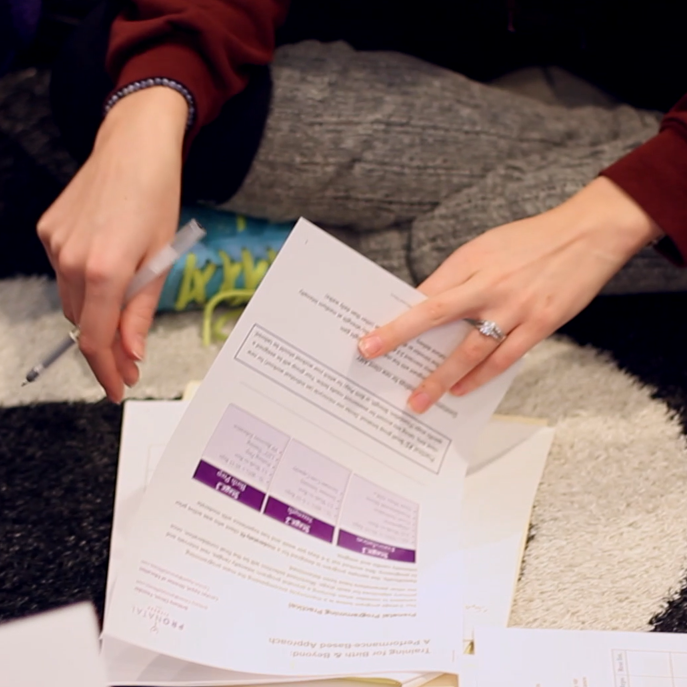A story from ProNatal Fitness Director of Education, Carolyn Appel
Earlier in my career, I dove into my personal training job with all of my energy: working 14-hour days to pull off floor shifts, taking classes to learn critical topics, and keeping myself in shape while fighting constant fatigue. Eventually, I transitioned to being a full-time trainer (ditching the floor-shifts) and faced the exciting and invigorating task of guiding the fitness futures of real people.
I was definitely in my element, teaching people movement skills and observing the learning process in real-time. I had been a college athlete so movement was my native language. The work thrilled me and I couldn’t wait to see my clients each week. However, I began to feel the pull of wanting to personalize each client’s experience with the time-consuming task of having to write programs for them. Suddenly, my 14 hour days were growing even longer, and the fatigue was becoming too difficult to fight off. I wanted to create the best program for each of my clients, but I also needed to be more efficient in my process or I was going to burnout – fast.
The Fundamentals of Effective Program Design
Program design is one of the most essential services personal trainers provide, but it can also be one of the most challenging aspects of the job. Some common challenges include:
- Balancing client personalization with your own time efficiency
- Understanding a client’s goals, but lacking a clear roadmap of how to get them there
- Having a client who wants to train for an activity you are not familiar with
- Finding new ways to add variety to prevent clients from getting bored
The key to addressing these challenges is to have a structured process that you go through with every client. This is exactly what we teach you in our mini-course: A Simple Guide to Program Design. You’ll come away with a clear step-by-step process to design big picture training programs that will help all your clients — not just your pre & postnatal ones — consistently progress, stay motivated, and achieve their goals.
A “Novel” Approach to Program Design
In many ways, writing a good training program for a client is similar in structure to writing a novel. Think of it this way:
- The Assessment = Inputs needed for story arc
- The Macrocycle = Story Arc
- The Mesocycles = Chapters
- The Microcycles = Paragraphs within a chapter
- Programming Variables = The descriptive details that keep the reader interested and engaged
Like a good novel, a well thought-through training plan ensures that training sessions build on one another in a cohesive way to help clients consistently progress and stay engaged. But don’t worry, writing a training program does not have to be nearly as overwhelming as writing a novel! We’ll walk you through every step of the process – complete with worksheets and case studies – to help you easily build a successful “novel” for all your clients.
The “4 Big Rocks”
The process begins by gathering the following “4 Big Rocks” from your assessment.
- Goals: Understanding the biomechanics and energetic demands needed to meet them
- Experience: A client’s movement literacy and intensity familiarity
- Limitations: Medical conditions, pains, or restrictions
- Commitment: How much time client has to reach goal and how many days per week they can devote to achieving this goal
You’ll learn how to gather this information from the assessment and use it to develop your client’s macrocycle. From there, you’ll learn how to break your macrocycle down into smaller, skill-based stages (mesocycles). Then, we’ll show you how to structure your individual workouts (microcycles) so they flow together in a cohesive way to avoid “session whiplash” and ensure your client consistently progresses while staying engaged and motivated.
This programming structure can be applied to clients of all types. In fact, at the end of the course, we’ll show you program design case studies for a prenatal client, postpartum client, a senior, an athlete, and a “fitness enthusiast” with no specific training goals.
Learn more about our mini-course: A Simple Guide to Program Design
Final words from Carolyn Appel…
If the idea of program design seems unfamiliar or overwhelming to you, know that you already possess the key ingredient needed to write better programs: desire to want to help your clients improve. That is likely why you got into this field. And if you are here with those intentions, then you will definitely benefit from this mini-course. I wish I had this type of a course earlier in my career. It would have saved me so many hours (and the frustration of diving down the rabbit hole of Eastern European periodization to learn schemes that I almost never refer to anymore).
